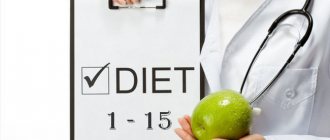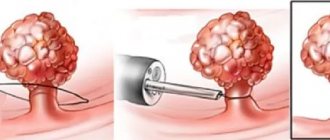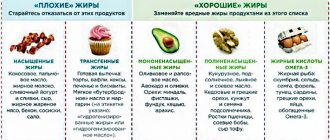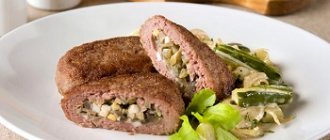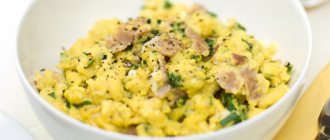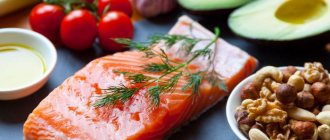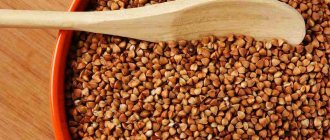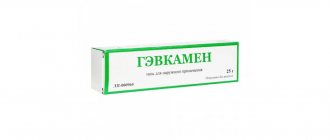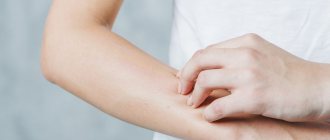Table No. 1 for illnesses
Let's look at the features of diet for some diseases.
For stomach ulcers
Table number 1 is indicated for exacerbation of the disease. The need to use varieties of medical diet - 1a and 1b arises only with severe exacerbation in the first days of the disease. Then the food is served boiled and not pureed. For stomach and duodenal ulcers, meals are taken up to 6 times a day; everything spicy, salty, smoked, and canned is removed from the diet.
As the ulcers scar, symptoms subside and health improves, they move on to the general table. Frequent meals and the optimal amount of protein in the diet are also recommended. Since the latter reduces the activity of glandular cells, which leads to a decrease in the production of gastric juice, and also has a neutralizing effect on it. And consuming soy flour before meals for a period of 4–6 weeks reduces the production of pepsin and normalizes the peristaltic function of the stomach. Recently, the influence of diet therapy on the healing time of ulcers has been questioned.
For gastroduodenitis
Gastroduodenitis is accompanied by damage to both the stomach and duodenum. If the pathology comes from the intestine itself, that is, there is primary duodenitis, not provoked by pathology of the pancreas (pancreatitis), gall bladder (cholecystitis, cholelithiasis) or biliary tract, then in this case table No. 1 is introduced.
The emphasis in nutrition is on limiting fats and carbohydrates (sugar, honey), irritating foods are excluded, the diet is low in salt - 5-6 g per day. Avoid foods that can cause fermentation in the intestines - legumes, baked goods, some vegetables (cabbage, radishes, turnips), carbonated and alcoholic drinks. Frequent meals are also necessary, avoiding hot and cold foods. Food is steamed, boiled, pureed.
For gastritis
Inflammatory diseases of the stomach are corrected by nutrition, taking into account the secretory function of the stomach. With reduced formation of gastric juice (autoimmune form of chronic gastritis) in the acute phase of the disease, all products that irritate the gastric mucosa are excluded:
- strong broths, rich soups;
- strong tea, coffee;
- salty dishes;
- smoked meats;
- coarse vegetable fiber;
- spicy foods;
- products with added spices.
For gastritis, meals are taken in small portions, every 2-3 hours. The amount of protein provided is slightly less than for peptic ulcers - about 15-20 g. The ratio of BZHU is 1: 1: 4.
After exiting the acute phase, the purpose of dietary nutrition is to stimulate the work of the gastric glands, aimed at increasing the formation of hydrochloric acid. Mechanical irritants are added to the diet - stale white bread, crackers, dry cookies, kefir, yogurt, diluted milk (if it is well tolerated). A fragmented diet and restrictions on fats and fried foods also remain.
For infectious gastritis, preference is given to table 1b with a diet of 4–5 times a day. Remove juicey, irritating dishes. Food comes in semi-liquid form, with carbohydrates limited, since the latter increase the activity of the stomach glands. Cooking is carried out without frying.
The diet includes mucous and milk soups with buckwheat, semolina, oatmeal, pearl barley, soft-boiled eggs, soufflé, quenelles, meat cutlets, and fish. From the second week of illness, the diet is expanded to table No. 1 with a gradual transition to the general table as recovery progresses.
With erosions in the stomach (erosive gastritis), nutrition is structured in the same way as with a peptic ulcer.
For GERD (gastroesophageal reflux disease)
For reflux, nutrition according to Pevzner has a number of features.
- The diet includes a high protein content, which helps to increase the tone of the lower esophageal sphincter. It is because of its deficiency that aggressive digestive juice from the stomach enters the esophagus, which disrupts the functioning of the organ.
- Avoid foods that increase pressure in the stomach and carbonated drinks.
- Limit fats as they slow down gastric emptying.
- Foods you should avoid: pork, beef, cold cuts, sea fish, rice, pasta, fresh bread, cream, butter, cheeses with a fat content of more than 20%, spices, pickles, citrus fruits, nuts.
general characteristics
Goal of the diet:
moderate chemical, mechanical and thermal sparing of the gastrointestinal tract with adequate nutrition, reducing inflammation, improving the healing of ulcers, normalizing the secretory and motor functions of the stomach.
General characteristics:
In terms of calories, protein, fat and carbohydrate content, it is a physiologically complete diet. Strong stimulants of gastric secretion, irritants of its mucous membrane, the portion that lingers in the stomach and difficult to digest foods and dishes are limited. Food is prepared mainly pureed, boiled in water or steamed. Some dishes are baked without a crust. Fish and non-rough meats are allowed in pieces. Table salt is moderately limited. Very cold and hot dishes are excluded.
Chemical composition and calorie content:
- carbohydrates - 400-420 g;
- proteins - 90-100 g (60% animals),
- fats - 100 g (30% vegetable),
- calories - 2800-3000 kcal;
- sodium chloride (salt) 10-12 g,
- free liquid - 1.5 l.
Diet:
5-6 times a day. Before bed: milk, cream.
Grocery list
Let's look at what people on diet #1 can and can't eat.
Authorized Products
| Flour products | Dried bread made from premium flour, biscuits, dryers. |
| Cereals | Semolina, rice, buckwheat, oatmeal, boiled in water or half milk, pureed, semi-viscous. |
| Soups | Vegetables with well-cooked cereals or pureed, seasoned with low-fat sour cream, egg-milk mixture. |
| From meat and fish | Steamed or boiled beef, young lamb, chicken, turkey, rabbit. Lean fish (pike, hake, cod, pollock) in pieces, steamed without skin, and also in the form of cutlets, quenelles, casseroles. |
| Vegetable dishes | Boiled vegetables (potatoes, carrots, cauliflower, beets) or in the form of souffles, purees, puddings. Pumpkin, zucchini, and broccoli are also allowed. |
| Dairy | Milk, cream, cottage cheese in the form of quenelles, lazy dumplings, puddings, fermented milk products with slight acidity |
| Snacks | Jellied fish in vegetable broth, boiled sausage, boiled tongue, salads from boiled vegetables. |
| Egg dishes | Steamed egg white omelette, soft-boiled eggs. |
| Sweet dishes, fruits | Fruit puree, baked apples, jelly, mashed compotes. |
| Beverages | Freshly squeezed diluted juices from sweet berries and fruits, jelly, weak tea, coffee drink, coffee, rosehip decoction, still mineral water. |
| Oils | Butter, peeled sunflower, corn, olive are added to dishes. |
Prohibited Products
| Flour products | Rye bread, fresh bread, muffins, puff pastries. |
| Soups | Rich meat and fish broths, steep vegetable soups, mushroom broths, cabbage soup, borscht, okroshka. |
| Cereals | Millet, corn, barley, pearl barley. |
| From meat and fish | Goose, duck, pork, semi-finished products, stringy meat, smoked meat and fish, meat, canned fish, fatty fish. |
| Vegetables | White cabbage, turnips, radishes, rutabaga, salted, pickled and pickled vegetables, legumes (peas, beans, lentils), spinach, sorrel. Dill can be added to salads and ready-made dishes. |
| Dairy | Fermented milk products with high acidity. |
| Beverages | Carbonated, strong tea, coffee, alcohol, sour juices, freshly squeezed undiluted juices, kvass. |
| Sweets | Ice cream, sweets, cakes, pastries. |
| Other | Spicy snacks, seasonings, ketchup, mayonnaise, tomato paste, mustard, hot sauces, chili, horseradish dressing, etc. |
Diet modifications
The “1 table” diet has two modifications: 1A and 1B.
Diet "Table 1A"
“Table 1A” is indicated for exacerbations of peptic ulcer disease, exacerbations of chronic gastritis with high acidity. The task of table No. 1a is to provide the body with all the necessary nutrients during an exacerbation and to provide favorable conditions for reducing inflammation.
All foods on the Table 1A diet must be boiled, steamed, baked without crust, and then chopped. Chopped, pureed, slimy food is the main condition and difference of this modification of the table. During an exacerbation, porridges should be crushed or slimy, poultry and fish should also be chopped and cooked in the form of soufflés or steamed cutlets. Vegetables and fruits are also thermally processed and crushed.
The list of allowed foods on table No. 1 is suitable for the diet, with the exception of all flour products, fermented milk products and confectionery. The nutritional value of this table is lower and is reduced by carbohydrate foods, since the patient is on bed rest.
The duration of the diet is on average 10 days. After this, “Table 1B” is prescribed for 14 days.
Food Frequently Asked Questions
Below we will look at a number of frequently asked questions.
Is it possible to eat fruits and what kind?
You can eat sweet fruits and berries in the form of puree, jelly, baked, drink berry compotes, jelly, diluted juices. Varieties include bananas, apples, peaches, pears, nectarines, apricots, and berries: strawberries, raspberries, cherries.
What types of lean meat and fish are allowed? Chicken, beef, rabbit, turkey, and lean lamb are allowed from animal and poultry meat. Fish allowed are hake, pollock, cod, saury, blue whiting, pike, and perch.
Menu for one day (without chopping food)
- 1st breakfast: egg, crumbly buckwheat, black tea with milk.
- 2nd breakfast: decoction of rose hips, fresh non-acidic cottage cheese.
- Lunch: vegetarian soup with potatoes, boiled or baked meat, boiled carrots. We drink compote made from dried fruits.
- Afternoon snack: wheat bran boiled with sugar and breadcrumbs.
- Dinner: baked or boiled fish with sauce, apple and carrot puree, black tea with milk.
- Before going to bed, drink a glass of milk or cream.
Menu
For your convenience, a menu has been developed below for every day and for the whole week.
Menu for every day for 5 meals a day:
| Breakfast | Steamed protein omelette, pureed oatmeal. |
| Dinner | Vegetarian puree soup of rice and vegetables with the addition of low-fat sour cream, meat puree, milk jelly. |
| Afternoon snack | Apple baked with sugar, rosehip infusion, dried. |
| Dinner | Steamed fish soufflé, viscous milk buckwheat porridge, tea with sugar. |
| Before bedtime | Boiled milk. |
Menu for a week for 5 meals a day
| Monday | |
| Breakfast | 2 boiled soft-boiled eggs, milk jelly. |
| Dinner | Vegetable soup seasoned with butter, steamed chicken cutlets, dried fruit compote without sugar. |
| Afternoon snack | Fruit puree, diluted apricot juice. |
| Dinner | Lazy dumplings with sour cream, tea with milk. |
| Before bedtime | A glass of milk. |
| Tuesday | |
| Breakfast | Steamed protein omelette, pureed oatmeal, weak tea. |
| Dinner | Buckwheat soup, turkey quenelles, rosehip infusion. |
| Afternoon snack | Baked apple, dried fruit compote. |
| Dinner | Steamed fish cutlets, baked vegetables, coffee drink. |
| Before bedtime | A glass of milk. |
| Wednesday | |
| Breakfast | Oatmeal porridge with half milk is viscous, cottage cheese with berries, weak tea. |
| Dinner | Pumpkin puree soup, meat casserole, oatmeal jelly. |
| Afternoon snack | A glass of milk, drying. |
| Dinner | Jellied fish in vegetable broth, vegetable puree from potatoes, cauliflower and zucchini, tea. |
| Before bedtime | A glass of curdled milk. |
| Thursday | |
| Breakfast | Buckwheat milk porridge, mashed, soft-boiled egg, tea. |
| Dinner | Noodle soup, chicken breast meatballs, apple compote. |
| Afternoon snack | Fruit puree, biscuits. |
| Dinner | Cottage cheese pudding, rosehip infusion. |
| Before bedtime | Boiled milk. |
| Friday | |
| Breakfast | Semolina porridge, soft-boiled egg, weak tea with milk. |
| Dinner | Buckwheat soup with vegetables, boiled chicken breast. |
| Afternoon snack | Fruit jelly, biscuits. |
| Dinner | Fish dumplings, assorted steamed vegetables. |
| Before bedtime | Boiled milk. |
| Saturday | |
| Breakfast | Milk soup with homemade noodles, steamed omelette, oatmeal jelly. |
| Dinner | Potato soup, boiled turkey, dried bread, coffee drink. |
| Afternoon snack | Fruit puree, curdled milk, straws (unsalted). |
| Dinner | Pumpkin and carrot puree, fish cutlets, tea. |
| Before bedtime | Not sour kefir. |
| Sunday | |
| Breakfast | Steamed protein omelette, pureed oatmeal, coffee drink with milk. |
| Dinner | Vegetable soup seasoned with butter, steamed chicken cutlets, rosehip infusion. |
| Afternoon snack | Steamed cottage cheese souffle, boiled milk. |
| Dinner | Fish and vegetable casserole, mashed potatoes. |
| Before bedtime | Curdled milk. |
What foods should be excluded from the diet?
With exacerbation of gastritis, a number of foods can provoke a deterioration in the general condition. To avoid negative consequences, the following are excluded from the menu during therapy:
- White bread and flour products.
- Kefir, yogurt and other fermented milk products.
- Cottage cheese.
- Root vegetables and other fresh vegetables.
- Boiled eggs.
- Kvass and carbonated drinks.
- Spicy, fatty snacks.
- Semi-finished products.
- Legumes.
- Whole pasta.
- Sour fruits.
- Sauerkraut.
- Mushrooms, etc.
A detailed list of prohibited and permitted products is selected by a gastroenterologist. The specialist also monitors the patient’s condition at all stages of therapy and, if necessary, makes adjustments to the treatment process. Self-medication for acute gastritis is prohibited!
Recipes
All the recipes below are suitable for people who follow the Pevzner diet table 1.
First meal
Vegetable soup with beets
Take: 2 medium beets, 2 carrots, 2-3 potatoes, 1 onion, sour cream, dill, salt. Preparation: Boil the beets whole in their skins. While the beets are cooking, peel and chop the onions, potatoes, and carrots. Grate the carrots. Pour water into a saucepan, place the chopped vegetables in it, and put on fire. Cool the beets, remove the peel, grate them, and place them in the pan. Before turning off the soup, add salt and dill. Serve with sour cream.
Pumpkin soup with croutons
Take half a medium pumpkin (about 500 g), 1 onion, 1 carrot, 50 g low-fat cream, salt, crackers. Preparation: Peel the onions and carrots. Finely chop the onion, grate the carrots, heat the vegetables in oil in a frying pan for 1 minute. Peel the pumpkin and cut it into small pieces to make it cook faster. Place it in a saucepan and add some water and the rest of the vegetables. Once the vegetables are cooked, cool a little and blend with a blender, add salt, add cream, and bring to a boil. Serve the puree soup with croutons.
Second courses
Turkey with zucchini
Take: 500 g turkey fillet, 2 onions, 1 large carrot, 1 medium zucchini, sour cream, dill, salt, vegetable oil. Preparation: Wash and cut the turkey. Peel the vegetables, cut them, lightly simmer the onions and carrots in a frying pan with a little water. Mix sour cream with salt and pour it over the vegetables, stir. Place the vegetables in the baking sleeve, then the turkey, secure the bag tightly on both sides and place in a preheated oven for 1 hour. Serve the dish with finely chopped dill.
Fish quenelles
Take: 500 g fish fillet (or fish with few bones), 2 onions, 100 g bread, dill, salt, half a glass of cream, egg. Preparation: wash the fish, remove bones. Cut into small pieces. Peel the onion and cut into quarters. Soak the bread in cream. Then the fish, onions and bread need to be twisted in a meat grinder. If you decide to take a bony fish, for example, pike, then you will need to twist it 2 times in order to grind the small bones well.
Add salt, finely chopped dill, egg to the minced meat, stir well. Place a pan of water on the gas. While the water is heating, make balls from the minced meat. As soon as the water boils well, carefully lower the balls into the water, stirring lightly for 15 minutes. Then place the quenelles in a dish and serve with sour cream and herbs.
Salads
Beetroot and chicken breast salad
Take: 1 medium beet, 3 potatoes, 150 g chicken breast, sour cream, dill, onion. Preparation: Boil vegetables and meat. Grate the beets, cut the potatoes into cubes, finely chop the breast. Chop the onion and pour boiling water for 5 minutes to remove the bitterness. Mix vegetables with breast, season with sour cream, sprinkle with dill on top.
Carrot, apple, raisin salad
Take: 2 carrots, 1 apple, half a glass of raisins, sour cream. Preparation: Peel the carrots and grate them. Remove the core from the apple, cut off the peel, and cut into cubes. Rinse the raisins well and soak in boiling water for 10 minutes. Mix carrots, apples, raisins with sour cream. Salad ready.
Dessert
Curd cookies
Take: 2 cups of flour, half a cup of water, half a cup of vegetable oil, egg, 1 tbsp. sugar, 300 g of cottage cheese, soda on the tip of a knife. Preparation: mix water, butter, sugar, egg, add cottage cheese, then flour. Stir well. The dough should turn out like thick sour cream. Grease a baking sheet with oil and spoon the dough onto the sheet. You can use a special cookie cutter. Bake for 30 minutes.
Indications for prescribing treatment table No. 1
Medical diet number 1 is prescribed for:
- peptic ulcer;
- exacerbation of chronic gastritis with normal or high acidity;
- acute gastritis in the recovery stage;
- with gastroduodenitis;
- infectious diseases of the gastrointestinal tract (in the absence of diarrhea);
- diaphragmatic hiatus hernia;
- the indication for the appointment of table No. 1 is gastrointestinal oncology.
The main symptoms of gastrointestinal diseases: pain in the epigastric region, nausea, vomiting, belching, loss of appetite. The appearance of one or more symptoms is a reason to visit a doctor. Diet table 1 is designed to provide peace to the gastric mucosa and the possibility of its speedy recovery.
Table No. 1 after operations
When prescribing therapeutic nutrition according to Pevzner after operations, surgical modification of diet 1a and 1b is used.
Features of surgical table 1a:
- prescribed 2–3 days after surgery;
- provides maximum unloading of the gastrointestinal tract (gastrointestinal tract);
- easily digestible forms of nutrients are used;
- food comes with maximum sparing of the digestive tract - in crushed form;
- food temperature is less than 45 degrees;
- BJU ratio is 1:1:5, 50 g of protein and fat, 250 g of carbohydrates per day;
- energy value up to 1600 calories;
- additional enrichment of nutrition with vitamins and microelements;
- sharp restriction of salt to 5 g per day;
- additional liquid 1.5-1.8 l;
- frequent meals - up to 6 times a day, in portions of no more than 350 g at a time.
Patients are then transferred to table 1b as digestion is restored. Dishes are pureed and pureed, the temperature of hot dishes is up to 50 degrees, cold - more than 20 degrees. The BJU ratio changes slightly to 1:1:4(4.5), the calorie content of the diet increases to an average of 2500 calories, additional liquid to 2 liters, salt to 6 g.
The transition from diet 1a to 1b occurs gradually, first expanding on individual products. If well tolerated, new products are continued to be introduced. Be sure to monitor symptoms of digestive disorders (diarrhea, flatulence, increased peristalsis), and the appearance of pain. Products that cause such symptoms are excluded from the diet for a long time (up to several months).
The prescription of therapeutic diets is combined with the intake of special enteral mixtures - balanced foods with high nutritional value, enriched with vitamins and microelements. As the diet expands, the amount of nutritional mixtures is reduced. Let's take a closer look at the nutritional features after operations on the intestines and gall bladder.
After intestinal surgery
The diet should be aimed not only at ensuring the restoration of substances important for the functioning of the body lost during the intervention (electrolytes, water, proteins, fats, carbohydrates, vitamins, microelements, etc.), but also at the earliest possible activation of digestion.
Since it was “turned off” during the operation, absorption from the digestive tract is therefore impaired immediately after the operation. And now the task is to “start” digestion and absorption again, restore the normal composition of the microflora and generally normalize the functioning of the digestive tract.
On days 3–6 after surgery, therapeutic nutrition begins to be introduced; the start time is based on the patient’s condition. Too early a transition to natural nutrition after intestinal surgery significantly worsens the course of the recovery period.
Therapeutic nutrition is carried out through the appointment of table No. 0a, 1, 1b surgical. Surgical diets have a generally low nutritional value and are combined with the use of special nutritional mixtures for oral administration. A few days after surgery, patients' diet is expanded to surgical table 1a, which is prescribed for up to 4 days.
After another 10 days, a smooth transition is made to surgical diet 1b, and then to surgical diet number 1, while the pureed version will have to be followed for a long time. And in the first 3–4 weeks after discharge from the hospital, patients are prescribed surgical table No. 1 in a wiped form. After this, there is a transition to the unprocessed version of diet 1.
Good tolerance of a new dish indicates that the restoration of the digestive system is proceeding correctly, namely: the ability to produce digestive juices, digest incoming food and remove unnecessary contents from the intestines.
If any product is poorly tolerated, patients after intestinal surgery should not exercise their intestines, that is, when they specifically load the intestines with products that are poorly accepted by them so that they “get used” to them. These workouts can aggravate the deficiency of intestinal enzymes and provoke the development of irreversible phenomena.
With the development of intolerance to milk and dairy products - manifested by the inability to digest milk sugar lactose, whole milk should be excluded for a long period. This applies to a lesser extent to fermented milk products (kefir, cottage cheese, yogurt, sour cream). Dairy products can be replaced with soy products; they have a set of amino acids similar in chemical composition to milk proteins, but are superior to animal milk proteins due to unique biologically active substances.
After gallbladder surgery
The principles of therapeutic nutrition in the rehabilitation of patients who have undergone gallbladder removal have not changed significantly over the past decade. Usually the following scheme is followed:
- On the first day you cannot eat or drink.
- On the second day, they begin to introduce liquid a little at a time, gradually increasing it to 1 liter; you can drink in small sips. Mineral still water, rosehip decoction with gradual expansion to decoctions of dried fruits, weak tea, and low-fat kefir are allowed. All drinks come without added sugar. By the 3rd day, the total volume of liquid is brought to 1.5 liters.
- Then unsweetened vegetable and fruit juices (from pumpkin, carrots, beets, rose hips, apples), fruit jelly, mashed potatoes, tea with sugar, pureed soups with meat broth of the second or third cooking are introduced. Food intake is in small portions, such nutrition continues until the 5th day after surgery.
- After a week, the menu continues to expand: white bread crackers, savory cookies, dried porridges, pureed porridges (buckwheat, oatmeal, wheat) with water or half and half with milk, cottage cheese, twisted meat (beef, veal, chicken, rabbit), boiled fish, vegetable puree, fermented milk products.
- Starting from 1.5 weeks and up to 1.5 months, a gentle diet (all dishes are steamed or boiled).
Modifications: 1A and 1B
Diet table No. 1 has two modifications: No. 1A and 1B. For table No. 1A, all dishes are prepared in liquid and porridge form or in the form of mashed puree. It is recommended to eat 6-7 times a day, while vegetables in any form, as well as fruits and bread are strictly prohibited. Such a strict diet is prescribed in the first two weeks of exacerbation of a peptic ulcer, acute or chronic gastritis, as well as a week after gastric surgery.
Table 1B differs from table 1A in the ratio of proteins, fats and carbohydrates and calorie content. Dishes are also prepared in liquid or porridge form, and you need to eat 5-6 times; vegetables, fruits and bread are prohibited. Table No. 1B is prescribed after completion of the course of treatment using table No. 1A.
Reviews
We bring to your attention reviews from readers and doctors about diet table 1.
Reader reviews
“There was an exacerbation about 1.5 years ago. Treatment was prescribed (omeprazole, nosh-pa, Almagel A, diet). They didn’t describe the diet, so I looked on the internet, at least roughly, because... Sometimes articles contradict each other. For the first few days I ate practically nothing at all, I simply couldn’t fit and was extremely heavy. Then I started eating lenten food, then slowly non-lenten food.
The result is this:
- Diet helps a lot, especially when you don’t feel like eating at first. During this period it is not difficult to hold, because you don't feel hungry.
- But when the severity passes, you really want to eat and return to your previous way of life.
- Now I have another exacerbation (after antibiotics). This time I tried to treat it with diet first - it didn’t help, I started taking medicine again and sticking to the diet - it started to help.
The sore is generally unpleasant, especially for me, because... I love to eat, BUT there is also a good side, you have to cook the right food)).”
"Good afternoon! I had gastritis as a child, when I was 14 years old, but my mother refused to take me to the doctor and said that I needed to eat more and faster, but this did not help. Then I went to the library and took out a bunch of health magazines, which I studied. I noticed that I got heartburn when eating very fatty foods, and I gave it up, although with my mother’s scandal, but over time she came to terms with it, I also began to eat only before 19 o’clock, and if I wanted to eat after 19 o’clock, I drank a glass of kefir with bread.
I began to adhere to a non-strict diet, excluding those foods to which I had a reaction. At the moment I am already 38 years old, gastritis no longer bothers me. The diet was not difficult to stick to. Now I eat almost everything, within reasonable limits and if I really want to, sometimes even later than 19 hours, but gastritis does not torment me. This is my story.) Sincerely, Elena".
What is forbidden to eat during a diet for stomach ulcers
People with this condition should not eat foods that may increase stomach acid production, increase acidity levels, or put too much strain on the digestive organs. Junk food must be avoided. This includes fatty foods, fried, smoked and very salty.
These foods should be excluded from your diet if you have an ulcer:
- spices and herbs;
- alcohol;
- soda;
- fast food;
- strong tea and coffee;
- nuts;
- citruses.
Diet table number 1 for children
Diet table number one can be prescribed by specialists as a therapeutic nutrition system for some childhood gastrointestinal diseases. The list of restrictions and recommendations regarding cooking methods are the same as in dietary table No. 1 for adults, but for children the pureed version of the menu is almost always recommended.
Author of the article:
Kuzmina Vera Valerievna |
Endocrinologist, nutritionist Education: Diploma of the Russian State Medical University named after. N.I. Pirogov, specialty “General Medicine” (2004). Residency at the Moscow State Medical and Dental University, diploma in Endocrinology (2006). Our authors
Fully or partially limited products
- Excluded from the diet: any types of bread, bakery and confectionery products.
- Any broths.
- Fried foods.
- Fatty fish and meats, as well as rough meats with connective tissue (bird skin, fish and cartilage).
- There is a complete exclusion of vegetables and fruits in any form except jelly and jellies.
- You should not consume fermented milk drinks, cheese, regular cottage cheese, or sour cream.
- Mushrooms (as a difficult-to-digest product), smoked meats and various snacks.
- Coffee, strong tea, cocoa, carbonated drinks, vegetable juices and undiluted fruit juices are prohibited.
- Sauces (vinegar, ketchup, mayonnaise) and spices are prohibited.
Table of prohibited products
| Proteins, g | Fats, g | Carbohydrates, g | Calories, kcal | |
Vegetables and greens | ||||
| vegetables | 2,5 | 0,3 | 7,0 | 35 |
| horseradish | 3,2 | 0,4 | 10,5 | 56 |
Cereals and porridges | ||||
| corn grits | 8,3 | 1,2 | 75,0 | 337 |
| pearl barley | 9,3 | 1,1 | 73,7 | 320 |
| millet cereal | 11,5 | 3,3 | 69,3 | 348 |
| barley grits | 10,4 | 1,3 | 66,3 | 324 |
Bakery products | ||||
| white bread crackers | 11,2 | 1,4 | 72,2 | 331 |
| rye crackers | 16,0 | 1,0 | 70,0 | 336 |
| wheat bread | 8,1 | 1,0 | 48,8 | 242 |
| Rye bread | 6,6 | 1,2 | 34,2 | 165 |
Confectionery | ||||
| jam | 0,3 | 0,2 | 63,0 | 263 |
| candies | 4,3 | 19,8 | 67,5 | 453 |
Ice cream | ||||
| ice cream | 3,7 | 6,9 | 22,1 | 189 |
Raw materials and seasonings | ||||
| mustard | 5,7 | 6,4 | 22,0 | 162 |
| ketchup | 1,8 | 1,0 | 22,2 | 93 |
| mayonnaise | 2,4 | 67,0 | 3,9 | 627 |
| ground black pepper | 10,4 | 3,3 | 38,7 | 251 |
| chilli | 2,0 | 0,2 | 9,5 | 40 |
Dairy | ||||
| kefir | 3,4 | 2,0 | 4,7 | 51 |
| sour cream | 2,8 | 20,0 | 3,2 | 206 |
| curdled milk | 2,9 | 2,5 | 4,1 | 53 |
Meat products | ||||
| pork | 16,0 | 21,6 | 0,0 | 259 |
Sausages | ||||
| dry-cured sausage | 24,1 | 38,3 | 1,0 | 455 |
| sausages | 12,3 | 25,3 | 0,0 | 277 |
Bird | ||||
| smoked chicken | 27,5 | 8,2 | 0,0 | 184 |
| duck | 16,5 | 61,2 | 0,0 | 346 |
| smoked duck | 19,0 | 28,4 | 0,0 | 337 |
| goose | 16,1 | 33,3 | 0,0 | 364 |
Fish and seafood | ||||
| dried fish | 17,5 | 4,6 | 0,0 | 139 |
| smoked fish | 26,8 | 9,9 | 0,0 | 196 |
| canned fish | 17,5 | 2,0 | 0,0 | 88 |
Oils and fats | ||||
| creamy margarine | 0,5 | 82,0 | 0,0 | 745 |
| animal fat | 0,0 | 99,7 | 0,0 | 897 |
| cooking fat | 0,0 | 99,7 | 0,0 | 897 |
Non-alcoholic drinks | ||||
| black tea | 20,0 | 5,1 | 6,9 | 152 |
| * data is per 100 g of product | ||||
